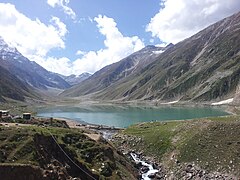Lake Saiful Muluk
From Wikipedia, the free encyclopedia
| Lake Saiful Muluk | |
|---|---|

Saiful Muluk during June
| |
| Location | Kaghan Valley |
| Coordinates | 34.876957°N 73.694485°E |
| Lake type | Alpine/Glacial lake |
| Primary inflows | Glaciers water |
| Basin countries | Pakistan |
| Surface area | 2.75 km2 (1.06 sq mi) |
| Surface elevation | 3,224 metres (10,577 ft) |
| Settlements | Naran |
Saiful Muluk (Urdu: جھیل سیف الملوک) is a mountainous lake located at the northern end of the Kaghan Valley, near the town of Naran.[1] It is in the north east of Mansehra District in the Khyber-Pakhtunkhwa province, Pakistan. At an elevation of 3,224 m (10,578 feet) above sea level, it is well above the tree line, and is one of the highest lakes in Pakistan.
Contents
[hide]- 1Location
- 2Physical features
- 3Ecology
- 4Folklore
Location[edit]
Saiful Muluk is located in the Mansehra district of Khyber Pakhtunkhwa, about eight kilometers north of Naran,[2] in the northern part of Kaghan valley. Malika Parbat, the highest peak in the valley is near the lake.[3]
The lake is accessible from the nearby town of Naran throughout the summer season.
Physical features[edit]
Saiful Muluk was formed by glacial moraines that blocked the water of the stream passing through the valley.[4] The Kaghan Valley was formed in the greaterPleistocene Period dating back almost 300,000 years when the area was covered with ice. Rising temperatures and receding glaciers left a large depression where glaciers once stood. Melting water collected into the lake.
Ecology[edit]
The lake has rich eco-diversity and holds many species of blue-green algae. Large brown trout are found in the lake, up to about seven kilograms.[5] About 26 species of vascular plant exist in the area, with Asteraceae the most commonly found specie. Other species commonly found in the region are: Ranunculaceae,Compositae, Cruciferae, Gramineae, Apiaceae, Leguminosae, Scrophulariaceaeand Polygonaceae.[1]
Folklore[edit]
A fairy tale called Saiful Muluk, written by the Sufi poet Mian Muhammad Bakhsh, talks of the lake.[6][7] It tells the story of the prince of Persia who fell in love with a fairy princess at the lake.[8] A poet and writer from Balakot], Ahmed Hussain Mujahid, wrote the story of Saiful Muluk in prose depicting the local version. There is also a cave (based on the name of the giant who pursued the prince) at the lake, with glistening pebbles and flowing water. The cave was the hiding place of Prince Saif and the fairy Badr when the giant was trying to find them. Locals say that due to a miracle the giant turned into a statue while searching for them. The cause of some torches and mobile phones not working in the cave is still a mystery.




Comments
Post a Comment